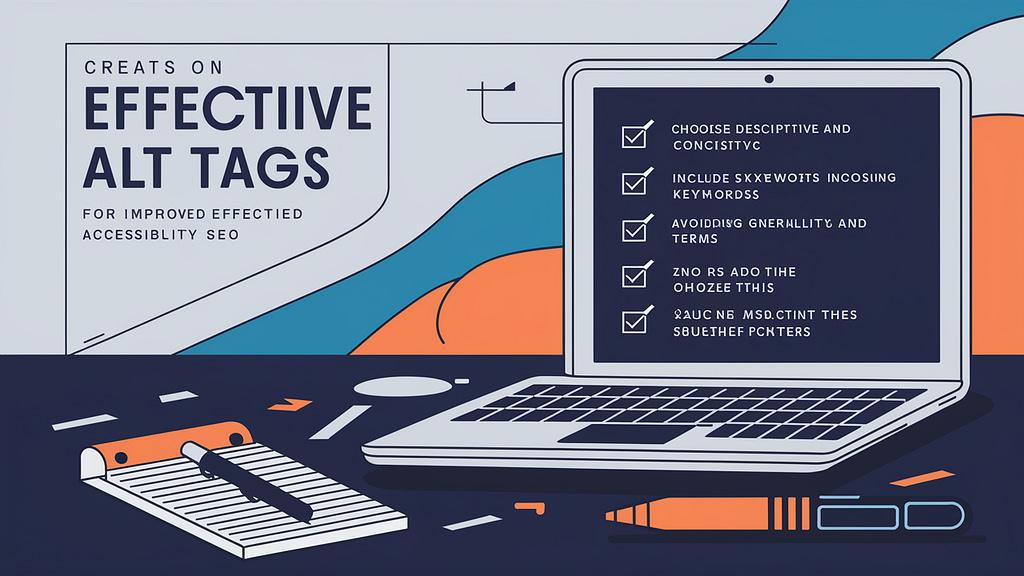In today’s digital world, ensuring web accessibility is crucial. Alt tags, or alternative text descriptions, play a significant role by making images accessible to visually impaired users and enhancing search engine optimization (SEO). Properly implemented alt tags provide descriptions for those using screen readers and help search engines understand image content, boosting a website’s visibility.
This article will explore essential alt-tag best practices that improve accessibility and SEO, guiding you to create a more inclusive and discoverable website.
Understanding Alt Tags
Alt tags, or alternative text descriptions, are HTML attributes applied to webpage image elements. Their primary function is to describe the content and function of an image in a manner accessible to all users, including those with visual impairments. When an image fails to load, the alt text is displayed instead, providing users with essential information about the image.
From a technical perspective, an alt tag is structured in HTML as follows:
html
<img src=”example.jpg” alt=”A description of the image”>
Alt tags serve a crucial role in web accessibility. For visually impaired users who rely on screen readers to navigate the web, alt text provides a textual description of images, enabling them to understand the content and context. This inclusion ensures that all users can access and engage with the content, regardless of their abilities.
Beyond accessibility, alt tags are significant for search engine optimization (SEO). Search engines like Google use alt text to comprehend the content of images since they cannot interpret images in the same way humans do. By providing descriptive alt tags, website owners can improve their search engine ranking by ensuring that search engines accurately index and understand image content.
The Importance of Alt Tags for Accessibility
Alt tags are vital for web accessibility, particularly for visually impaired users who rely on screen readers. These tags provide spoken descriptions of images, enabling users to understand their content. Beyond legal requirements, alt tags enhance the overall user experience for everyone by providing additional context and inclusivity. In the subsequent sections, we will delve into best practices for writing effective alt tags to improve accessibility and SEO performance.
The SEO Benefits of Alt Tags
Alt tags serve a dual purpose: they enhance web accessibility for visually impaired users and improve SEO performance. By providing valuable context about image content, alt tags help search engines understand the relevance of images to the overall webpage context.
Optimized alt tags with relevant keywords increase the likelihood of images appearing in search results and contribute to a webpage’s overall relevance and authority. Ultimately, incorporating descriptive alt tags aligns with SEO best practices, enhancing visibility and better user experience.
Best Practices for Writing Effective Alt Tags
Crafting effective alt tags is essential for both accessibility and SEO. By following best practices, you can ensure that your alt tags accurately describe image content while incorporating relevant keywords to improve search engine visibility.
Be Descriptive and Specific
When writing alt tags, strive to be descriptive and specific. Provide concise yet informative descriptions that accurately convey the content and function of the image. Avoid generic or vague descriptions; instead, focus on providing meaningful context that enhances the user experience.
Keep it Relevant
Ensure that your alt text is directly relevant to the image and the surrounding content on the webpage. Alt tags complement the surrounding text and contribute to the overall narrative of the page. Avoid using alt text solely for keyword stuffing or unrelated content, as this can detract from the user experience and may be seen as spammy by search engines.
Avoid Keyword Stuffing
While it’s essential to incorporate relevant keywords into your alt tags, avoid keyword stuffing at all costs. Alt text should sound natural and be written for human readers, not search engines. Overloading alt tags with keywords can detract from their effectiveness and may even result in penalties from search engines.
Use Appropriate Length
Strive to balance being descriptive and concise with your alt text. While there is no strict character limit for alt tags, aim to provide enough information to convey the image’s content without being overly verbose. Ideally, alt text should be concise while still providing valuable context.
Include Text in Images Sparingly
If an image contains text essential to understanding its content, replicate it in the alt tag. However, avoid including redundant text in alt tags for images with accompanying textual content nearby. Alt tags should enhance accessibility without duplicating information unnecessarily.
Common Mistakes to Avoid
When crafting alt tags, be mindful of common mistakes that can compromise their effectiveness:
- Leaving Alt Tags Blank: Always provide descriptive alt text to ensure accessibility.
- Using Generic Descriptions: Avoid vague terms like “image” and provide specific descriptions.
- Overloading with Keywords: While keywords are important, avoid stuffing alt tags with excessive keywords.
- Neglecting Image Relevance: Ensure alt tags are directly relevant to the image and surrounding content.
Avoiding these mistakes ensures that your alt tags effectively serve their purpose, enhancing accessibility and SEO.
Advanced Alt Tag Optimization Tips
For optimal alt tag performance:
- Contextual Integration: Align alt text with surrounding content to provide a cohesive user experience.
- Image File Names: Choose descriptive names that clarify image content and aid search engine comprehension.
- Testing and Validation: Regularly validate alt tags using accessibility tools and screen readers to ensure readability and effectiveness.
- Regular Audits: Conduct periodic reviews of alt tags to maintain accuracy and relevance, aligning with evolving content and SEO strategies.
By incorporating these strategies, you can enhance the effectiveness of your alt tags, improving both accessibility and search engine visibility.
Conclusion
In summary, alt tags are fundamental to web accessibility and SEO. They make images understandable to all users and improve search engine rankings. By adhering to best practices and avoiding common pitfalls, websites can ensure their alt tags effectively convey image content while enhancing user experience and search engine visibility.
Furthermore, implementing advanced optimization strategies, such as contextual integration and regular audits, ensures that alt tags remain accurate and relevant. This commitment to alt-tag optimization reflects a dedication to inclusivity and user-centric design principles, ultimately benefiting all website visitors.
As the digital landscape continues to evolve, the importance of alt tags in facilitating accessibility and maximizing SEO impact cannot be overstated. By prioritizing alt-tag optimization, website owners can create a more inclusive online environment while enhancing their website’s performance and reach.

